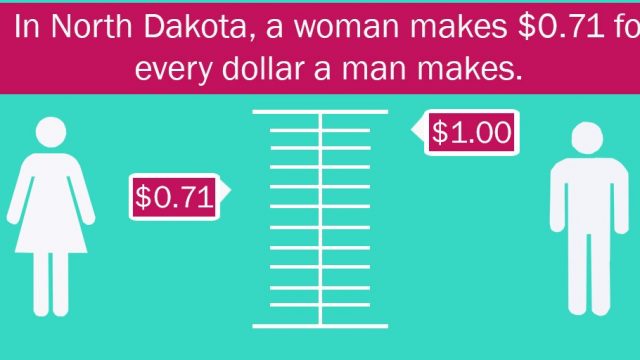"Equal Pay Day" Is Bunk

North Dakota Demcorats today are making a big stink about “Equal Pay Day,” and it’s bunk.
For the uninitiated, Equal Pay Day is about raising awareness of the gap between pay for men and women. It’s bunk because the statistic which serves as the foundation for this political talking point is pointless.
Here’s Senator Heidi Heitkamp touting it in a Tweet:
25,000 households in ND are headed by women -& yet, on avg, women earn $0.71 for every $1 earned by men #EqualPayDay pic.twitter.com/JeM2SUhkOZ
— Sen. Heidi Heitkamp (@SenatorHeitkamp) April 12, 2016
If that statistic were describe men and women doing the same jobs, with the same level of experience and training and education, then Senator Heitkamp and everyone else touting it would have a point.
But they don’t have a point, because that statistic is merely a comparison of all female full-time workers to all male full-time workers. And the simple truth is that men and women do not work the same sort of jobs, nor do they approach their careers in the same way.
Men and women, in the aggregate, make different sorts of choices which have much more impact on their career earnings than any sort of discrimination or bias.
For instance, according to data from the Bureau of Labor Statistics, men typically work longer hours, but when men and women work the same number of hours it’s women who tend to make more:
Among full-time workers (those working 35 hours or more per week), men were more likely than women to work a greater number of hours (see Table 5). For example, 26% of men working full-time worked 41 or more hours per week in 2014, compared to only 14.8% of women who worked those hours, meaning that men working full-time last year were almost twice as likely as women to work 41 hours per work or more. Further, men working full-time were also 2.5 times more likely than women to work 60+ hour weeks: 6.6% of men worked 60 hours per week or more in 2014 compared to only 2.6% of women who worked those hours. Also, women working full-time were 2.5 times more likely than men to work shorter workweeks of 35 to 39 hours per week: 11.8% of full-time women worked those hours in 2014, compared to only 4.8% of men who did so. What’s especially interesting is that women working 35-39 hours per week last year earned 13.7% more than men who worked those hours, i.e. there was a 13.7% gender wage gap in favor of female workers for that cohort.
Also of note is the fact that men tend to work more dangerous jobs of the sort that command more pay. This from economist Mark Perry:
…men represented 92.3% of workplace fatalities in 2014 (and the male share of job-related deaths has been consistently that high in every previous year) because men far outnumber women in the most dangerous, but higher-paying occupations like logging, mining and roofing that have the greatest probability of job-related injury or death. In contrast, women, more than men, show a demonstrated preference for lower risk occupations with greater workplace safety and comfort, and they are frequently willing to accept lower wages for the greater safety and reduced probability of work-related injury or death.
Choices such as marriage and being a mother tend to impact how much a woman makes. Again, via Professor Perry, here’s a graph showing the percentage women make compared to men based on their choices with regard to marriage and motherhood. As you can see, women who are not married and have no children make 94 percent as much as men (keep in mind, these comparisons don’t include other factors like career choice and number of hours worked):

You could argue that we should do more to encourage young women to branch out into traditionally male-dominated areas of study and work – and I think we should – but these are choices being made by young women which impact their earning potential negatively. I think it’s hard to claim some widespread bias is leading to lower pay for women when, in reality, choices women make tend to contribute to the wage gap much more.
If “Equal Pay Day” were about encouraging women to make choices in their lives to enhance their earning potential, then I’d be fine with it. But in reality it’s just an opportunity to gripe about unequal outcomes for unequal work, and that’s baloney.




